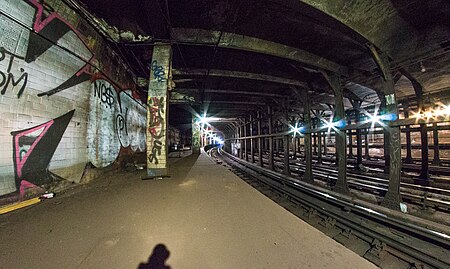Worth Street station

Worth Street was a local station on the IRT Lexington Avenue Line of the New York City Subway. It is located at Lafayette Street and Worth Street, in Civic Center, Manhattan. The Worth Street station was constructed for the Interborough Rapid Transit Company (IRT) as part of the city's first subway line, which was approved in 1900. Construction of the line segment that includes the Worth Street station started on July 10 of the same year. The station opened on October 27, 1904, as one of the original 28 stations of the New York City Subway. The southbound platform was lengthened in the late 1940s. The station was closed on September 1, 1962, as a result of a platform lengthening project at Brooklyn Bridge–City Hall. The Worth Street station contains two abandoned side platforms and four tracks. The station was built with tile and mosaic decorations. Many of these decorations have been covered with graffiti.
Excerpt from the Wikipedia article Worth Street station (License: CC BY-SA 3.0, Authors, Images).Worth Street station
Worth Street, New York Manhattan
Geographical coordinates (GPS) Address Nearby Places Show on map
Geographical coordinates (GPS)
| Latitude | Longitude |
|---|---|
| N 40.7155 ° | E -74.003 ° |
Address
Worth Street
Worth Street
10278 New York, Manhattan
New York, United States
Open on Google Maps








